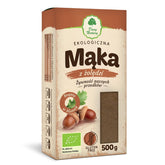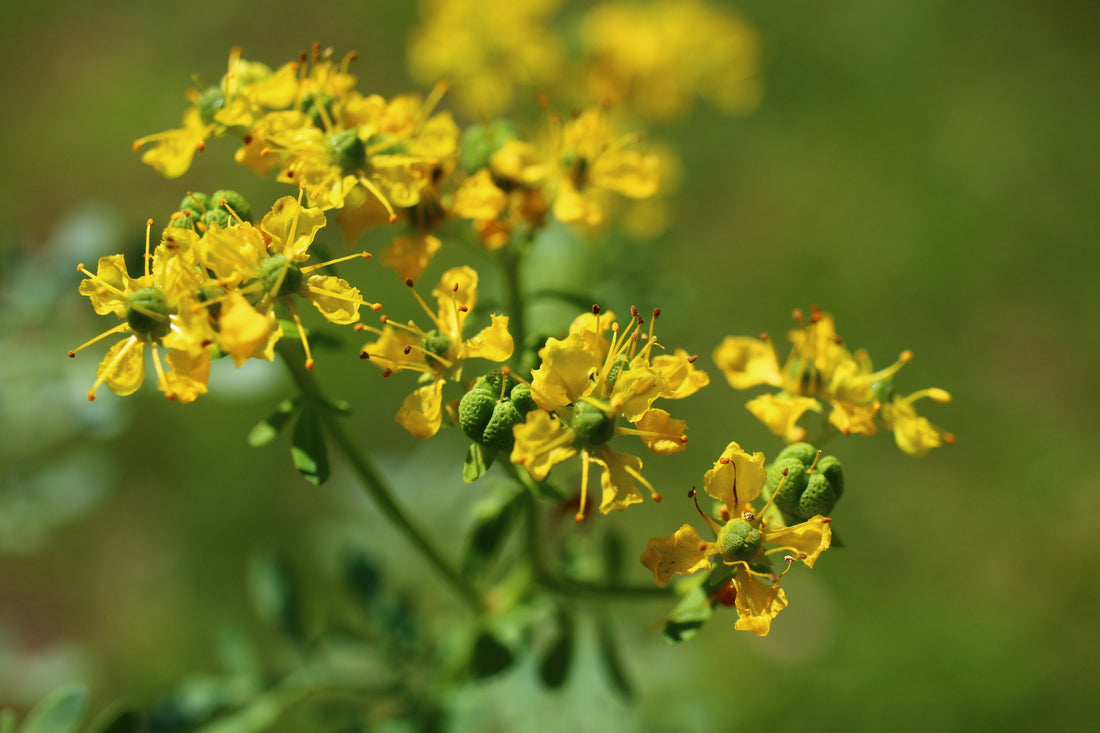Rue – the effect of an ancient herb
Contents:
- Where does rue come from and what is its morphology?
- What are the characteristics of rue?
- What are the indications for the use of rue?
- How do you dose rue correctly?
- Which preparations contain rue?
- Are there any contraindications to the use of rue?
Rue (Ruta graveolens), a member of the rue family (Rutaceae), has been valued in natural medicine for centuries. The plant has wide-ranging health benefits, helping the body fight gastrointestinal parasites, lower blood pressure, and improve peripheral circulation. It has antispasmodic, diuretic, choleretic, and analgesic properties and supports the function of the digestive system and internal organs. In addition to its physical benefits, rue relieves stress and tension, supports mental health, and restores peace.
Where does rue come from and what is its morphology?
Rue (Ruta graveolens), also known as garden rue or herb of grace, is a plant native to southern Europe, particularly Italy and southeastern Europe. It has been present in both domestic and monastic herb gardens for centuries, but in Poland it primarily serves a decorative purpose. Rue belongs to the rue family and is characterized by its unique flower structure and its intense, characteristic odor, which, combined with a distinctly bitter aftertaste, immediately draws attention.
Rue flowers have an interesting structure. The calyx consists of four sepals, and the corolla consists of four yellow, slightly depressed petals. Surrounding the nectary, eight stamens surround a four-part pistil, whose carpels are almost completely fused and filled with numerous ovules. The inflorescences are arranged in umbels, and what makes the rue special is that the apical flower, located at the end of the main axis of the inflorescence, consists of five parts, while the others consist of four. The carpels develop into multi-seeded capsules that burst open at the inner edges when ripe.
Ruta graveolens is a plant-based raw material. The upper parts of the shoots are harvested, usually during full bloom and again at the end of August.
What are the characteristics of rue?
Rue (Ruta graveolens) is valued both for its ornamental qualities and for its wide range of uses in natural medicine; interestingly, it is also used in cooking as a seasoning and game preservative. What gives rue such a broad spectrum of effects?
Numerous active ingredients contained in rue influence its health-promoting potential. The main components of this plant include:
- essential oil,
- Furanocoumarins,
- flavonoids,
- alkaloids,
- Coumarin,
- Umbelliferone,
- organic acids,
- Vitamin C,
- Mineral salts
The high concentration of flavonoids gives rue anti-inflammatory, detoxifying and antioxidant properties and supports the body in the fight against inflammatory processes and oxidative stress.
Coumarin, found in rue, is known for its anti-cancer properties, increasing the plant's potential use in cancer prevention. Ruta graveolens also has a positive effect on the circulatory system, reducing vascular permeability, supporting their elasticity, and increasing resistance to damage.
Thanks to its various therapeutic properties, rue also has antibacterial and antiulcer properties and helps regulate the function of the digestive system, reducing the risk of diarrhea. It also has immunomodulatory effects and supports the function of the immune system.
What are the indications for the use of rue?
Rue is a versatile plant. Among other things, it supports the function of the digestive system. It has properties that help combat indigestion, flatulence, intestinal inflammation, and abdominal pain, and also supports the prevention of gallstones. It also has beneficial properties for the urinary system, helping with reduced urine output and disorders of its composition. Rue has a positive effect on liver health, supporting its regeneration. Thanks to its properties, it also helps with arteriosclerosis and hypertension. The guanidine contained in the plant supports the function of the adrenal glands and lowers glucose levels, which helps reduce the risk of diabetes and has a positive effect on the body's carbohydrate metabolism.
When else is it worth using rue:
- Rue supports not only physical but also mental health by relieving stress, fatigue, nervous exhaustion and distraction while also having a calming effect.
- Rue is rich in essential oils and a popular ingredient in perfumes with a citrusy, balsamic scent. Rue infusion has anti-aging properties, brightens the complexion, and prevents the formation of spider veins.
How do you dose rue correctly?
The dried herb of rue is most commonly used and can be used in various forms, such as infusion, tea, oil extract, or tincture. Rue tea is particularly recommended for menstrual cramps, flatulence, and bloating. To prepare it, pour boiling water over one teaspoon of the herb (approx. 250 ml) and let it steep for 20 minutes. Rue infusion, on the other hand, is used externally for swelling, injuries, and toothaches. To prepare it, pour boiling water over one tablespoon of the herb and let it steep for one hour. After this time, the infusion is ready for use in the form of compresses, rinses, or washes.
Which preparations contain rue?
Rue is available in various forms from pharmacies, drugstores, and health food stores. It is most commonly found in capsule form as an extract, a natural dietary supplement that supports digestion, relieves flatulence, and improves digestive function. Rue is also a common ingredient in balms and warming ointments used to treat conditions related to muscle tension and pain. Rue is also available in dried herb form, which can be used to brew a refreshing beverage.
Are there any contraindications to the use of rue?
Rue should be used with caution, as there are certain situations in which its use may be discouraged. First of all, people who are allergic to plants in the rue family should avoid using it to avoid triggering allergic reactions. Pregnant and breastfeeding women should avoid this herb due to potential adverse health effects. Additionally, people who struggle with skin problems should avoid using rue, as it can aggravate dermatological symptoms. Men planning to expand their family should also avoid this herb, as it can negatively affect sperm motility, which can make conception difficult.
THE PUBLISHER'S CHOICE
Dried plums 1 kg BIOGO
- £6.07
- £6.07
- Unit price
- / per
Dried White Mulberries 500 g ORGANIC
- £5.06
- £5.06
- Unit price
- / per
Almonds 1 kg BIOGO
- £10.13
- £10.13
- Unit price
- / per
Cranberries sweetened with apple juice organic 1 kg BIOGO
- £14.19
- £14.19
- Unit price
- / per
Dried dates 1 kg BIOGO
- £3.65
- £3.65
- Unit price
- / per
Unpeeled buckwheat groats 1 kg BIOGO
- £2.44
- £2.44
- Unit price
- / per
Walnuts 800 g BIOGO
- £7.50
- £7.50
- Unit price
- / per
Peeled sunflower seeds 1 kg BIOGO
- £2.63
- £2.63
- Unit price
- / per
PULLED ORGANIC SUNFLOWER SEEDS 1 KG BIOGO
- £3.85
- £3.85
- Unit price
- / per












































































































































